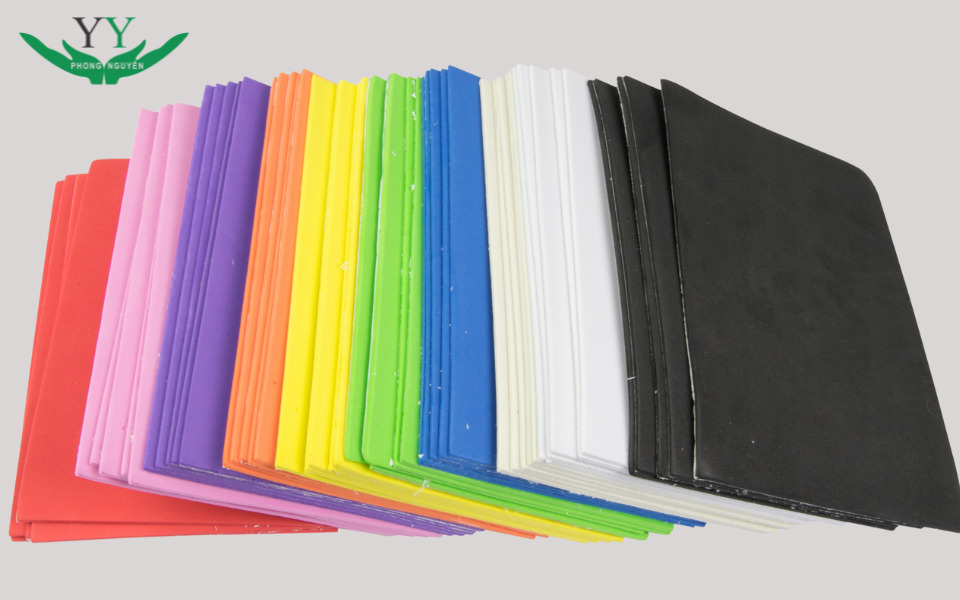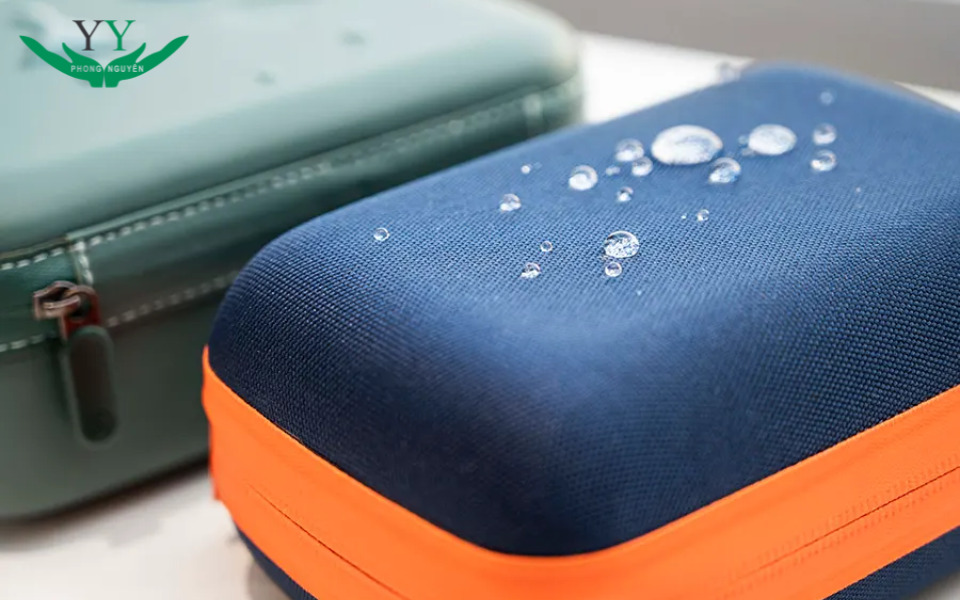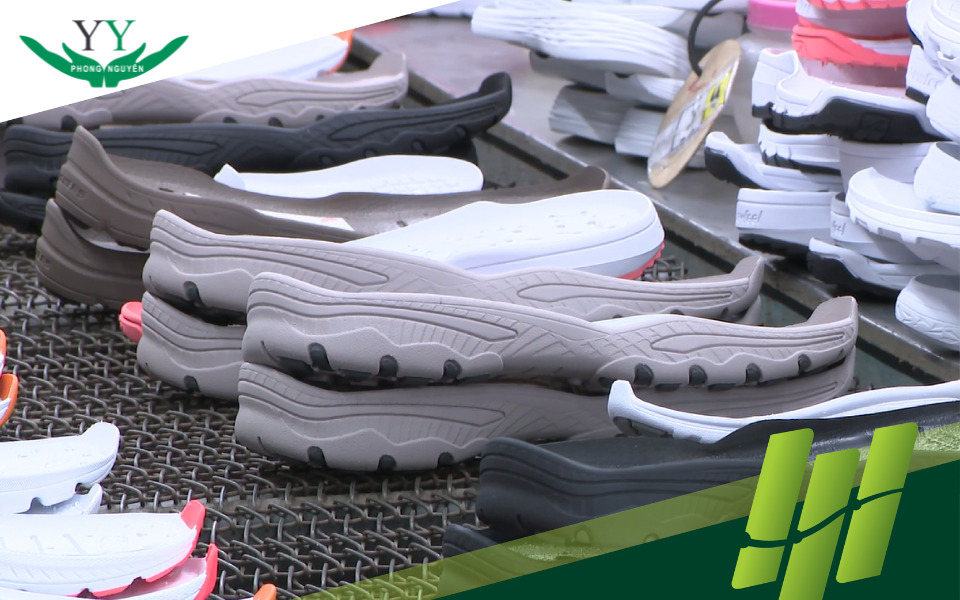EVA plastic is one of the most widely used polymer materials today thanks to its flexibility, safety, and eco-friendliness. From shoe soles and yoga mats to children’s toys, EVA plastic is ever-present in our daily lives. So, what is EVA plastic and why is it so popular?
What is EVA Plastic?
EVA (short for Ethylene Vinyl Acetate) is a synthetic flexible plastic made from two main components: ethylene and vinyl acetate.

EVA plastic is extensively used in daily life—from shoe soles, house slippers, yoga mats, and children’s toys to soundproofing and insulation materials in construction. In fact, you can find EVA in the protective linings of pastry boxes, electronic devices, or sporting goods.
Key Characteristics of EVA Plastic
EVA possesses a variety of outstanding characteristics that make it one of the most widely applied polymer materials in everyday life:
Soft and Highly Elastic
One of the most recognizable features of EVA is its softness and high elasticity. When compressed, squeezed, or bent, EVA can deform but quickly returns to its original shape. This property makes it ideal for use in shoe soles, shock-absorbing pads, and other products requiring excellent force absorption.
Water and Moisture Resistance
Due to its tight molecular structure and waterproof nature, EVA is unaffected by moisture or prolonged exposure to water. This makes it highly suitable for applications that demand water resistance, particularly in outdoor environments or humid conditions.

Excellent Thermal and Electrical Insulation
EVA exhibits efficient thermal and electrical insulation capabilities owing to its foam-like structure. It does not conduct heat, thus helping maintain temperature stability between surfaces and preventing heat transfer from the external environment. Furthermore, EVA is an excellent electrical insulator and can be safely used in electrical applications.
Non-toxic and Safe for Users
One of the reasons EVA is a popular choice in consumer products is its safety. EVA contains no harmful substances such as BPA (Bisphenol A), phthalates, or other toxic compounds typically found in PVC or synthetic plastics. As a result, EVA is odorless and does not cause skin irritation, making it suitable for children and individuals with sensitive skin.
Lightweight and Easy to Process
Another important advantage of EVA is its lightweight nature, which helps reduce transportation costs and simplifies product manufacturing. Additionally, EVA can be easily cut, bent, or bonded without the need for complex tools.

Resistance to Mild Chemicals
EVA resists certain mild chemicals such as oils, greases, soaps, and weak alkaline solutions. While it is not resistant to strong acids or harsh organic solvents, EVA remains a durable and stable material for most common applications in daily life.
Classification of EVA Resin
The vinyl acetate (VA) content in EVA is a crucial factor that determines its physical and mechanical properties. Based on VA content, EVA can be categorized as follows:
- Low VA content (≤ 10%): This type of EVA is harder and less flexible or elastic. However, it has excellent heat resistance and minimal deformation under heat. It is commonly used in applications requiring high durability and thermal stability, such as insulation materials, packaging, and construction components.
- Medium VA content (10%–20%): This is the most common type of EVA, offering a balance between flexibility and mechanical strength. Products made from medium VA EVA are typically water-resistant, elastic, and easy to process. Common applications include shoe soles, yoga mats, children’s toys, and shock-absorbing pads.
- High VA content (> 20%): With a higher VA percentage, this EVA variant is highly flexible and elastic, offering excellent impact resistance. However, it is less thermally stable. It is often used in products that require high flexibility, such as foam slippers, anti-slip mats, and protective pads in household or food industry applications.
Applications of EVA Plastic
EVA is a unique polymer material known for its softness, durability, and flexibility, making it highly versatile across various industries and everyday uses. Some of the most popular applications of EVA include:
Footwear
One of the most significant applications of EVA is in the footwear industry, particularly in the production of shoe soles. Thanks to its softness and excellent shock-absorbing properties, EVA provides comfort and ease for users, especially during prolonged wear or intense physical activity.

- Sports shoe soles: EVA is widely used in sports footwear to reduce impact during running or training. Its elasticity helps absorb shock and protects the feet from strong impacts.
- Indoor slippers: EVA is ideal for making lightweight and comfortable house slippers that are easy to clean and maintain.
- Shower slippers: Since EVA is waterproof and has good antibacterial properties, it is suitable for shower slippers, preventing wetness and reducing the risk of slipping in bathrooms.
- Protective work shoes: In industrial environments where workers are frequently on the move or exposed to hazards, EVA helps protect the feet from injuries due to impacts.
Read more: Discovering Common Different Types Of Soles for Sport Shoes
Toys
EVA is commonly used in the production of foam puzzle mats for children, often featuring alphabet letters, numbers, or animal shapes. These mats provide thermal insulation, shock absorption, and are lightweight and easy to clean. Their soft surface ensures a safe play environment, minimizing injury from falls.
Sports Equipment
Yoga mats made from EVA are highly favored due to their elasticity, anti-slip surface, and easy-to-clean material. The softness and lightness of EVA enhance comfort during yoga poses or exercise routines. EVA is also used to produce yoga blocks, foam rollers, knee and elbow pads, and other support tools.

Packaging
EVA is utilized to create foam inserts for packaging luxury items such as gift boxes, wine bottles, cosmetics, watches, and jewelry. Thanks to its easy-to-process nature, EVA can be cut or die-cut to match the product’s shape, keeping it secure and enhancing the overall aesthetic of the packaging. Furthermore, EVA can be dyed in various colors to meet high visual design standards.
Healthcare
EVA serves as a substitute for PVC in the production of IV bags and blood bags due to its high biocompatibility and absence of harmful plasticizers like phthalates. EVA can withstand sterilization by steam or gamma rays without deforming, allowing it to safely preserve medical fluids over extended periods.

Thanks to its light weight and elasticity, EVA is also used to manufacture medical cushions such as heel pads, orthopedic insoles, back supports for bedridden patients, and padding in orthopedic braces. These products help reduce pressure, prevent bedsores, and support recovery in mobility-impaired patients.
Electronics
A vital application of EVA in the electronics industry is as an insulating material for cables and circuit boards. Its excellent insulating properties help prevent short circuits and ensure safety when devices operate under high voltage or in humid environments.
Conclusion
EVA plastic is a versatile polymer material known for its outstanding flexibility, elasticity, non-toxicity, and ease of processing. We hope that this article from Phong Nguyen has provided you with a comprehensive understanding of what EVA is and its real-world applications. As industries increasingly prioritize safe, sustainable, and user-friendly materials, EVA is poised to continue playing a vital role across a wide range of modern manufacturing sectors.

